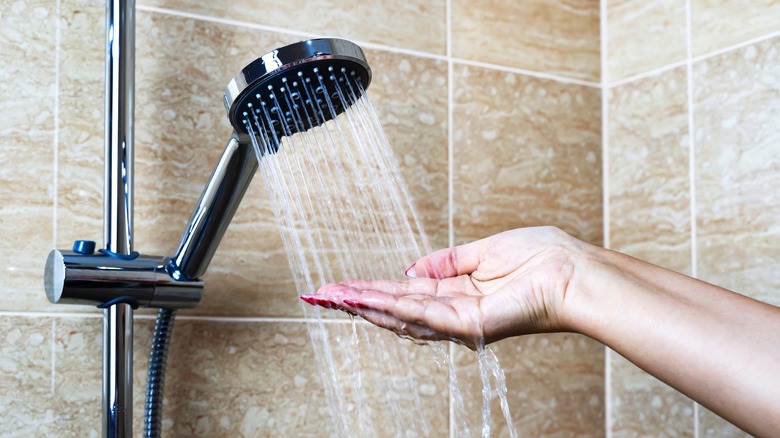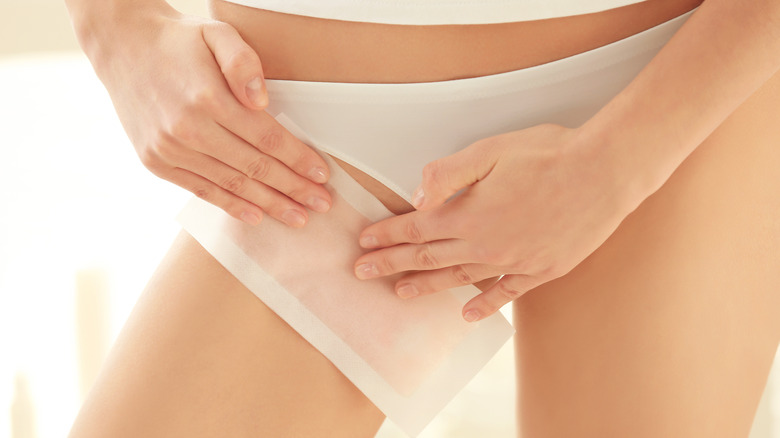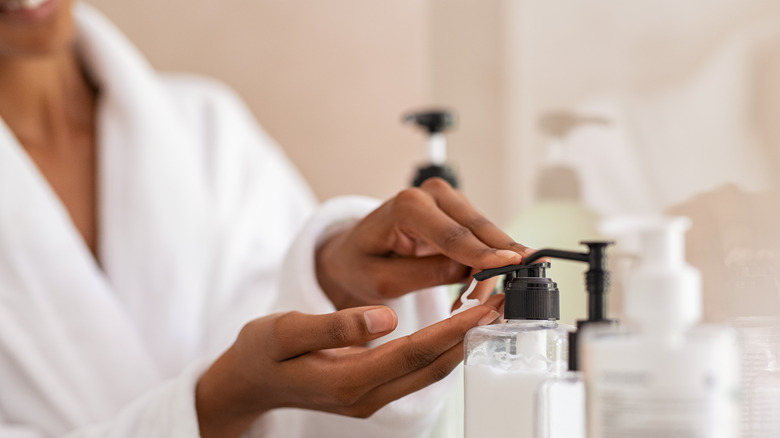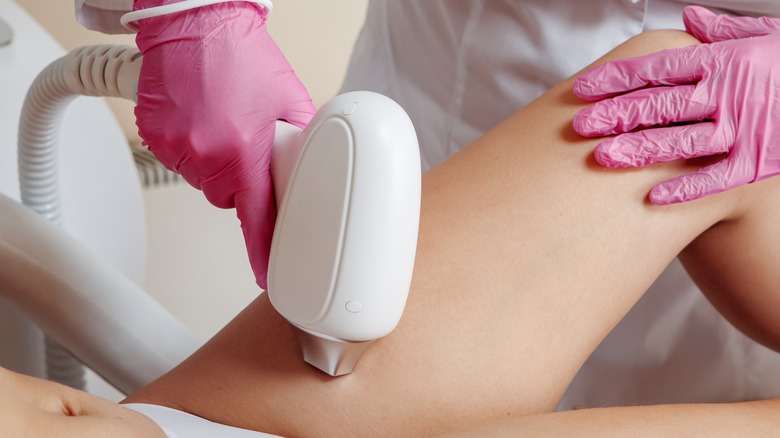If You Decide To Remove Your Pubic Hair, Make Sure You Do It Right With These 5 Tips
Body hair removal can be a sensitive (and painful) process, and there's perhaps no area that applies more to than your bikini area. FYI, you don't have to remove your pubic hair if you don't want to. Mayo Clinic explains that there's no health reason to groom down-there hair, and in fact, doing so may cause infections, irritation, and other complications. Having fewer pubic hairs may even make it easier to contract or transmit sexually transmitted infections.
Still, a whopping 84% of American women groom their pubic hair to some extent, according to a 2016 study published in "JAMA Dermatology." Ultimately, the decision to remove your hair or sport a full bush is a highly personal one. You may want to remove the strays that peek out of your bathing suit bottoms, shave the entire area to keep odor under control, or opt for something in between.
If you do decide to try a little landscaping in this sensitive spot, it's crucial to do it the right way. Put down the razor and waxing strips, and read these tips first.
Properly prep your skin
Removing hair from your vulva (the outer part of the female genitals) isn't something that should be done on a whim. You need time to prepare your skin in advance to help prevent irritation and injury — no one wants a bumpy rash on their bikini line! Start by gently washing the area where you'd like to remove hair. If you're planning to shave, it's best to run through your usual shower routine first to give the skin and hair time to soften, per Medical News Today. Then, shave while still wet — never dry shave if you want to prevent razor bumps.
While you might not need to step in the shower to wax, it's still a good idea to wash up in advance for the best results. As Chloe Scriminger, a trainer at the Ministry of Waxing, told Women's Health, "The cleaner the hair, the easier it is to grip."
Finally, leave time to exfoliate. "Regular exfoliation helps to prevent ingrown hairs," Dr. Hadley King, a board-certified dermatologist, shared with Byrdie. Gently exfoliate just before shaving or 24 to 48 hours before waxing.
Pay attention to the direction of hair growth
You may be eager to go to town shaving and waxing your pubic hairs away, but take a beat first to actually look at your hair. Notice which direction they grow — this will determine your hair removal technique.
If you plan to shave, be sure to work in the direction of hair growth, rather than against the grain. "This helps prevent razor bumps and ingrown hairs," board-certified dermatologist Dr. Azadeh Shirazi told Glamour. If this doesn't give you the close shave you want, try holding the skin tight with your non-dominant hand while gliding the razor in short strokes with the other.
With waxing, the technique is reversed. The American Academy of Dermatology Association notes that wax should be applied to the skin in the same direction the hair grows, but once it's time to remove the cloth strip, it should always be pulled in the opposite direction. This helps ensure you actually get clean results, without leaving any hairs behind.
Follow up with a moisturizer
Just because you've removed any unwanted pubic hair doesn't mean your work is over. Your skin may be especially sensitive after shaving or waxing, so it's important to soothe it with a moisturizer or lotion. Post-shave, apply a light lotion as soon as you step out of the shower, as you likely already do after shaving your legs or other areas of your body. If you waxed, wait a little longer to moisturize. "We'd recommend holding off on lotions, especially those with fragrance, for at least 24 hours," Courtney Claghorn, founder of hair-removal destination Sugared + Bronzed, revealed to Skincare.com.
There's another reason why fragranced lotions are a bad idea, no matter which hair removal method you choose: They're not so great for your vaginal health. According to Medical News Today, fragranced products don't belong anywhere near your vagina, as they can cause irritation and allergic reactions.
As for which moisturizers are A-OK, products formulated for sensitive skin or, even better, the bikini area specifically are generally safe. You can also look for natural ingredients like aloe vera, jojoba oil, and vitamin E, as hair-removal expert Eileen Bischoff told Women's Health.
Treat razor burn and ingrown hairs
Bikini area bumps and burns happen to the best of us, so if you notice some irritation after removing your pubic hair, know that you're not alone. Still, you shouldn't experience irritation every time you shave or wax. In the case of razor burn, Healthline points out that it's commonly caused by poor shaving technique. Next time, make sure you go slow and only shave wet, softened skin. And if you're using an old blade, take your razor burn as a sign to swap it for a fresh one. Once you notice razor burn on your bikini area (generally soon after shaving), moisturize and then wait it out — inflammation generally subsides within a few days.
Razor bumps and ingrown hairs, on the other hand, can take longer to appear, as well as longer to heal. Ingrown hairs are hairs that fold into the skin, rather than growing out normally, according to Medical News Today. When the hair becomes trapped, it can form a painful bump, often lasting up to a week or two. To speed up the healing process, try removing the ingrown hair by applying a hot compress until it moves to the surface of the skin. Then, use clean tweezers to pluck it out. You can also apply soothing creams (hydrocortisone ointments are a great option) to lower your risk of developing an infection.
Skip shaving and waxing if you have sensitive or easily irritated skin
Shaving and waxing are among the easiest hair removal options, but they might not work for you, especially if you have sensitive skin or tend to get pesky ingrown hairs. Chemical depilatories are hair removal creams that make it easy to wipe away unwanted hair, without the side effects sometimes associated with shaving, waxing, and other hair removal methods. Before using these creams, always do a small patch test to check for an allergic reaction, and choose sensitive-skin formulas when possible.
If you're tired of suffering through skin irritation every time you remove hair down there, a permanent solution, like electrolysis, is worth considering. Cleveland Clinic explains that electrolysis treatments destroy cells in the hair follicles, keeping them from triggering new growth. Expect to need several treatments for results.
Finally, reconsider removing large areas of hair around the bikini area. Though there's nothing wrong with wanting a full Brazilian wax or an itty-bitty landing strip, your skin may thank you if you keep things (mostly) au naturel. Try tweezing just the hairs that poke out of your underwear, for instance, or trimming with clippers or an electric trimmer for a shorter look.





